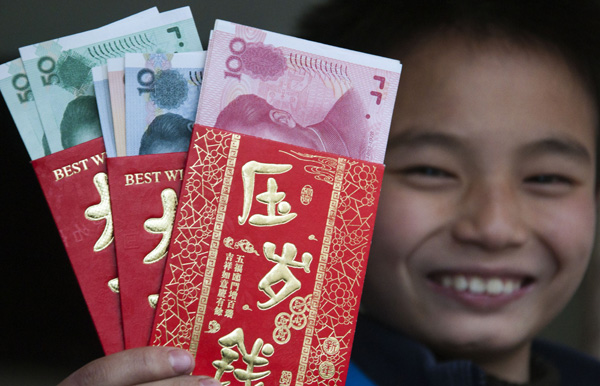Spring Festival custom 'twisted'
By Chen Mengwei (China Daily) Updated: 2014-02-17 08:35
 |
|
A boy shows the red envelopes he received during Spring Festival this year in Shaoyang, Hunan province. Lyu Jianshe / for China Daily |
The tradition and true meaning behind the giving of red envelopes to children during Spring Festival is being lost as people stuff them with ridiculously large amounts of cash or use them as a networking tool to cultivate favors in return, experts warn.
The tradition of handing out red envelopes spans 2,000 years to the Eastern Han Dynasty (AD 25-220), aiming to protest children from a monster named Sui that brings misfortune.
It is normally given to children up to their 18th birthday or, in some cases, when they get their first job.
Chen Hewen, 50, owns a wedding company, and tried to dissuade friends and relatives from giving large sums of money to his 12-year-old daughter, who just started middle school.
Despite his efforts, the girl still managed to get more than 7,000 yuan ($1,150), double the amount of last year.
Her father kept his donation to 200 yuan, an amount he has stuck to for seven years.
"I think it's pointless to give my child that much money," he said.
"It's just a huge burden. I have to pay it back to them anyway, one way or another, but they have all sorts of excuses, like the donation has to rise every year, or my daughter just entered middle school. If I hadn't tried to dissuade them, she could have easily earned more than 10,000 yuan."
A Beijing News survey this month of 90 primary and middle school students found that the recipients got 438,000 yuan, an average of 4,867 yuan each.
The survey indicated that children whose parents worked in the government or business tended to get more money in the envelope and from more people.
"It used to be of no real monetary value at all. The red envelopes used to have specially designed coins. It was like that for hundreds of years," said Wu Xinfeng, a senior member of the Chinese Folklore Society.
"But now people use real money and lots of it, and they are using the envelopes in exchange for favors. The spirit behind the tradition is being twisted."
- Top 5 Spring Festival customs in China
- Spring Festival customs in Zhouzhuang
- Light carnival a sparkling end to Spring Festival
- Simple but relaxing in the Spring Festival
- Officials report frugal Spring Festival holiday
- Taiwan media record Spring Festival customs
- Traditional red envelopes get a personal touch
- World's biggest red envelop shows up in Fujian
- More female officials caught in corruption
- Whampoa veterans recorded with glory
- Police bust 9 terrorist groups in Xinjiang
- Knife-wielding attackers seized in Xinjiang
- New regulation leads to drop in petitioned cases
- Hunan plant shut as probe into lead poisoning begins
- Police boost efforts to combat gambling
- Project offers jobs openings to legal experts
- Experts: Dog meat festival 'illegal'
- Nation looks to upgrade
pipeline networks






